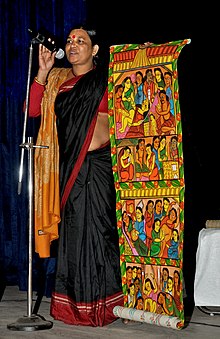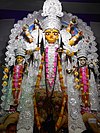Patua Sangeet
| Patua Sangeet পটুয়া সঙ্গীত | |
|---|---|
 | |
| Native name | Poter Gan পটের গান |
| Etymology | songs made my bengal patua |
| Stylistic origins | Blueblood of Bengal |
| Cultural origins | ancient time to present, Bengal region |
| Typical instruments | free voice and folk instrument |
| Regional scenes | |
| India (West Bengal) | |
| Local scenes | |
| Birbhum, Medinipur | |
Patua Sangeet or Poter Gan is a cultural tradition of Bengal Patachitra. It is performed by a Patua.[1] It is famous in the village part of West Bengal like Birbhum, Jhargram, Bardhaman and Murshidabad as a folk song of West Bengal.[2]
Classification
There are three types of Patua Sangeet according to the difference of Patachitra and there mythological stories. This lyrical drama is written about the Krishnilila, Gouranglila, Ramlila, Shib-Parbotiilila etc. is called Lila kahini. Panch Kalyani type music is not based on any particular story or adaptation. There are many sense of various gods and goddesses. So it's called Pancha Kalyani, the mixer of various stories. Gopalan or Cattlefarming story is another type of Patua Sangeet.[3]
Regions
Patua sangeet was prevalent in the entire the hole Bengal region, but now it is heard in Birbhum, West Midnapore, Nayagram of Pingla block in Jhargram, Bardhaman and Murshidabad district in West Bengal.[4][5]
Relation between Patachitra and Patua sangeet
Patua sangeet is not merely an emulation of Patachitra. It describes the inner meaning and thought of the Patachitra. Thus Patachitra and Patua sangeet are mutually dependent.[3]
The perfect form of Bengali life
This section is empty. You can help by adding to it. (February 2022) |
Patterns
Although the culture of Patua Sangeet is fading, some songs are still heard in some places of West Bengal. There are some ideas of pat singing from the different writers who compiled the songs.[6][3]
Pancha Kalyani giti
Nama mahēśbara digambara īśāna śaṅkara.
Śiba śambhu śūlapāṇi hara digambara
Krishna pater giti
Hari binē br̥ndābanē āra ki brajē śōbhā pāẏa.
Jalē kr̥ṣṇa sthalē kr̥ṣṇa kr̥ṣṇa mahimanḍalē.
Jam pater giti
Arira putra yamarāja yama nāma dharē,
binā aparādhē yama kā'uri danḍa nā'i karē.
Ēkajana balatē tārā du'i janē yāẏa,
kē'u dharē culēra muṭhi kē'u dharē gāẏa,
pāpī lōka halē gō tāra mastaka phāṭāẏa.
Bhālō jala thākatē yē jana manda jala dēẏa,
mr̥tyukālē nabakakuṇḍē mukhē tāra jala dēẏa.
Gajir pot giti
Pērathamētē dēkhēna kartā ṭhākura jagannātha
rāma-lakṣmaṇa naẏā hanu laṅkā ca'ilā yāẏa.
Rābaṇa ā'isyā yōgīra bēśē sītā haraṇa karē
śūrpanakhāra nāka yēmana lakṣmaṇa ṭhākura kāṭē.
Kamarati bāmana dēkhēna chinnamastā kālī
tāraparētē dēkhēna kartā maẏūrapaṅkhī nā'ō.
Gājīra bhā'i kālu ā'ila niśāna dhariẏā
gājīra āchē ēkaṭā bāgha nāma yē khyanda'iẏā....
Artist
- Dukhushyam
- Pulin Chitrakar
- Gouri Chitrakar
- Rani Chitrakar
See also
References
- ^ Sri Ashutosh Bhattacharya. Bangiyo Loko-Sangeet Ratnakosh. Kolkata: Paschimbanga Loko Sanskriti Gobeshona Kendra. p. 1041.
- ^ "Myths and Folktales in the Patachitra Art of Bengal: Tradition and Modernity - The Chitrolekha Journal on Art and Design". The Chitrolekha Journal on Art and Design. 2015-08-02. Retrieved 2018-05-18.
- ^ a b c Gurusaday Dutta (1939). Patua Sangeet. Kolkata: Kolkata University. pp. Introduction page.
- ^ Bose, Nirmal Kumar. 1953. Folk religion of Bengal, part I number I (A study of the Vrata rites).C. Kar, Benoy Bose Road, Calcutta, India
- ^ "Patachitra: Ancient scroll painting of Bengal". Media India Group. 2017-04-26. Retrieved 2018-05-18.
- ^ "Archived copy" (PDF). Archived from the original (PDF) on 2018-05-12. Retrieved 2018-05-18.
{{cite web}}: CS1 maint: archived copy as title (link)

